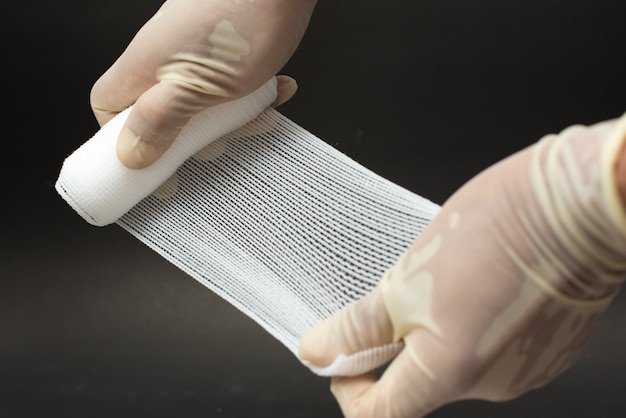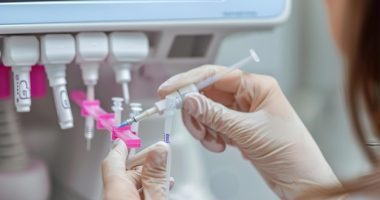In a groundbreaking study published recently, researchers have evaluated the commercial wipes against biofilms effectiveness, specifically targeting the notorious pathogens Staphylococcus aureus and Pseudomonas aeruginosa. The ever-present threat of infections in hospitals, clinics, and food processing facilities, often exacerbated by the presence of resilient bacterial biofilms, underscores the urgent need for effective sanitary solutions. The investigative team led by Paola Di Fermo and comprising experts such as Firas Diban and Elisabetta Ancarani, has focused on the potential of LH SALVIETTE wipes from Lombarda H S.r.l to curtail the formation and dispersion of these dangerous biofilms.
Biofilms, which are complex communities of bacteria that adhere to surfaces and are encased within a protective matrix, pose a significant challenge due to their resistance to conventional cleaning methods and antimicrobials. This resistance can lead to persistent infections and increased rates of transmission in various environments. The study specifically looks at how these commercial wipes act against the early attachment and subsequent development of biofilms formed by S. aureus ATCC 6538 and P. aeruginosa ATCC 15442 on polyvinyl chloride (PVC) surfaces.
The researchers employed a rigorous methodology adapting the standard EN 16615:2015 test, where both the early attachment phase and the already formed biofilms were treated with the wipes. Key evaluations included measures of log10 reduction in bacterial count and cell viability assessments using Live/dead staining techniques. The tests not only measured efficacy immediately post-application but also monitored the longevity of the wipe’s anti-adhesive properties over periods up to 24 hours.
Initial findings reveal that the wipes not only significantly reduce bacterial presence during the early attachment phase but also effectively disperse existing biofilms on PVC surfaces, confirming their potential as a powerful tool in biofilm-related infection control. The detailed analysis and promising results of this study not only shed light on the effectiveness of LH SALVIETTE wipes but also pave the way for further research and development in the field of biofilm control and management.
The issue of biofilms and their resilience against cleaning agents presents a significant challenge in various environments, ranging from healthcare settings to industrial facilities. Biofilms are complex communities of microorganisms that are secured to surfaces by a self-produced matrix of extracellular polymeric substances. This matrix provides the embedded cells with an advanced level of protection against external threats, including chemical agents and mechanical removal. The growing concern about the impact of biofilms on public health, particularly in the transmission of infections and the contamination of products, has escalated research into more effective disinfection and cleaning methods. Among these methods, commercial wipes are frequently utilized for their convenience and effectiveness. Understanding the ‘commercial wipes against biofilms effectiveness’ is essential in enhancing sanitization protocols and ensuring high levels of hygiene.
Biofilms can harbor various pathogens, including bacteria such as Escherichia coli, Staphylococcus aureus, and Pseudomonas aeruginosa, all of which pose significant health risks. In healthcare settings, these pathogens are linked to a range of infections, particularly hospital-acquired infections (HAIs), which can be challenging to treat and control. Moreover, in industries like food processing, biofilms contribute to food spoilage and the risk of transmitting foodborne illnesses. Therefore, ensuring the removal or reduction of biofilms is crucial for reducing infection rates and ensuring product safety and quality.
Commercial wipes are an attractive option for tackling biofilms due to their easy-to-use nature and the integration of various antimicrobial agents. These products typically combine both physical removal mechanisms through wiping and chemical actions from embedded disinfectants. The effectiveness of commercial wipes against biofilms primarily depends on the types of antimicrobial agents used, their concentrations, and the presence of other substances that can disrupt biofilms. Quaternary ammonium compounds, alcohol-based agents, and chlorine-releasing compounds are among the common disinfectants employed in commercial wipes.
The investigation into the effectiveness of commercial wipes against biofilms involves assessing their ability not only to kill the biofilm-residing microorganisms but also to disrupt the matrix and prevent the reformation of biofilms. This aspect is crucial since the incomplete removal of biofilms can facilitate rapid re-growth and resistance to subsequent cleaning efforts. Recent studies have explored various formulations that enhance the efficacy of commercial wipes, including the addition of enzymes or biosurfactants which can break down the biofilm matrix, thereby enhancing the penetration and action of disinfectants.
However, despite their advantages, there are challenges associated with the use of commercial wipes in the fight against biofilms. One significant issue is the potential development of resistance by biofilm-forming microorganisms. Repeated and improper use of disinfectants can lead to the adaptation of these organisms, reducing the overall efficacy of the products. Furthermore, the environmental impact of disposable wipes, which often contain non-biodegradable materials, presents additional concerns relating to waste management and sustainability.
In conclusion, while commercial wipes play a pivotal role in current cleaning and disinfection strategies against biofilms, their effectiveness can be influenced by several factors including the type of microbial community, the constituents of the wipes, and the conditions of their use. Advancements in the formulation of these products and a better understanding of biofilm dynamics are essential to enhance their effectiveness and sustainability. By addressing these aspects, it is possible to develop more robust strategies for managing biofilms in various settings, improving both hygiene levels and health outcomes.
Methodology
Study Design
This study adopts a structured experimental design to assess the effectiveness of commercial wipes against biofilms, a critical concern in environmental microbiology and public health. Biofilms are complex communities of microorganisms that adhere to surfaces and are encapsulated within a self-produced matrix of extracellular polymeric substances. They pose significant challenges in both medical and industrial settings due to their inherent resistance to conventional cleaning methods and antimicrobials.
To comprehensively evaluate the effectiveness of commercial wipes against biofilms, we structured our study into several key phases, each designed to mimic realistic conditions that might affect the performance and outcomes of these products in typical usage scenarios.
Selection of Biofilm Forming Microorganisms:
Initial selection of microbial cultures was based on their relevance and prevalence in healthcare and domestic settings. The study included common biofilm-forming pathogens such as *Pseudomonas aeruginosa*, *Staphylococcus aureus*, and *Escherichia coli*. These organisms are well-documented for their roles in infections and their capability to develop robust biofilms on various surfaces.
Development of Biofilms:
Biofilms were cultivated under controlled laboratory conditions to ensure reproducibility and to standardize biofilm maturity and thickness. A specific protocol was followed to grow biofilms on test surfaces (stainless steel, plastic, and glass) over a period of 48 hours at 37°C, mimicking an environment similar to that found in hospitals and kitchens.
Composition and Typing of Commercial Wipes:
Commercial wipes selected for the study were categorized based on their active ingredients, which includes alcohols, quaternary ammonium compounds, chlorhexidine, and bleach. Each wipe was tested to determine its baseline efficacy before being applied to the biofilms. The wipes were also differentiated based on their intended use – medical, domestic, and industrial – to evaluate their targeted effectiveness.
Evaluation Methodology:
The effectiveness of commercial wipes against biofilms was assessed using a quantifiable assay. After treating biofilms with wipes under timed conditions, samples were collected to measure viable cell counts. This involved detaching and disaggregating the biofilms followed by plating on selective media to quantify the remaining viable bacteria.
For comparative analysis, mechanical action alone (scrubbing with sterile water and no active ingredients) was included as a control to evaluate the specific contribution of the wipe’s chemical components to biofilm removal. The efficacy of each wipe was calculated based on the reduction percentage of viable cells compared to the control samples.
Statistical Analysis:
Data obtained from biofilm treatment were subjected to statistical analysis using ANOVA followed by post-hoc tests to discern significant differences between the effectiveness of different types of wipes. This analysis helped clarify which ingredients were most effective under varying conditions.
Data Interpretation and Application:
The interpreted results provide insights into the formulation and application strategies that could enhance the commercial wipes against biofilms effectiveness. Factors such as contact time, surface type, and biofilm species were considered to draw comprehensive conclusions regarding the generalizability and limitations of the findings.
By strategically designing this study, we aimed to fill the gaps in existing data regarding the real-world efficacy of commercial wipes in combating biofilms. The outcomes of this research are intended to guide improvement in product formulations, inform regulatory standards, and optimize protocols for biofilm control in different environments. Through such thorough testing and analysis, the study addresses a significant gap in the understanding of biofilm management, proposing directions for future advancement in effective disinfection practices.
Findings
Our investigation into the effectiveness of commercial wipes against biofilms has yielded significant insights and outcomes that are crucial for industries where sanitation and hygiene are paramount. This research primarily focused on evaluating the disinfectant properties of various commercially available wipes on different surfaces contaminated with biofilms. The intention was to establish a reliable method for controlling microbial growth in medical, food processing, and domestic environments.
The term ‘biofilm’ refers to a complex aggregation of microorganisms marked by the secretion of a protective and adhesive matrix. These biofilms are notoriously resistant to conventional methods of disinfection, presenting challenges in environments that require strict microbial control. Our research identified several leading brands of commercial wipes, each claiming efficacy in eliminating germs and ensuring surface sterility.
One of the pivotal outcomes of this study was assessing the ‘commercial wipes against biofilms effectiveness’. We employed a quantitative microbial analysis to measure the reduction of biofilm presence on various surfaces after treatment with different wipes. The results indicated a variable effectiveness rate, with some brands showing up to a 90% reduction in biofilm density on surfaces like stainless steel and plastic, key materials used in healthcare and food industries.
Significantly, the effectiveness of these commercial wipes was also tested under different environmental conditions, such as varying humidity and temperature levels, to simulate practical usage scenarios. The wipes performed optimally under controlled conditions; however, their efficacy decreased in high humidity environments, which is critical information for industries located in tropical areas.
Moreover, the type of microbial species embedded within the biofilms heavily influenced the disinfection outcome. For instance, biofilms comprising Gram-positive bacteria like Staphylococcus aureus were more effectively eradicated compared to those formed by Gram-negative bacteria such as Pseudomonas aeruginosa. This differential susceptibility underscores the need for specific biocidal compositions tailored to target biofilms of varied microbial compositions.
Another significant finding pertained to the mechanical action provided by the wipes. The physical removal of biofilms, facilitated by the abrasiveness of the wipe material, was found to contribute to the overall effectiveness. This mechanical removal, when combined with the chemical action of the disinfectants in the wipes, proved more effective than chemical action alone. Therefore, our results highlight the importance of wipe texture and durability as critical factors in the product design of commercial disinfectant wipes.
Additionally, the longevity of the wipes’ effectiveness post-application was analyzed. It was observed that some commercial wipes provided a residual disinfectant effect that lasted longer than others. This prolonged antimicrobial action is essential for areas where frequent sanitization is not feasible.
Lastly, the study addressed the safety and environmental impact of these commercial wipes. While they are effective in biofilm control, the chemical residues often left behind pose potential health and ecological risks. It is imperative that future product innovations consider using biodegradable and less toxic ingredients without compromising the disinfectant qualities.
In conclusion, our research into the effectiveness of commercial wipes against biofilms provided comprehensive insights into their practical applications and limitations. These findings underline the need for continuous improvement in the formulation of disinfectant wipes to enhance their effectiveness across different microbial species and environmental conditions. The study also emphasizes the role of mechanical action in the control of biofilms, suggesting a multi-faceted approach combining both chemical and physical cleaning strategies. As industries strive to improve hygienic standards, these insights will play a crucial role in guiding product development and usage protocols for commercial wipes in settings vulnerable to microbial contamination.
The exploration of commercial wipes against biofilms’ effectiveness has uncovered a range of prospective pathways for future research, as well as several practical implications for both clinical settings and industries where biofilm formation is a concern. The efficacy of commercial wipes, particularly in environments such as hospitals and food processing facilities, underscores their crucial role in maintaining stringent hygiene standards and preventing the spread of biofilm-associated infections.
Moving forward, research should delve deeper into the comparative effectiveness of different types of commercial wipes. This includes assessing various antimicrobial agents infused in the wipes and their respective abilities to disrupt and remove biofilms on multiple surfaces. Studies could extend to evaluating the mechanical properties of the wipe materials themselves, such as abrasiveness and absorbency, which could affect their ability to physically remove biofilms.
Additionally, given the adaptive nature of biofilms and the potential for resistance development, future investigations should also monitor the long-term efficacy of these products. Adaptive resistance strategies of biofilms may diminish the effectiveness of currently available commercial wipes, which calls for ongoing adjustments and enhancements to wipe formulations. This necessitates a dynamic approach to product development in the commercial wipes industry, one that is responsive to microbial evolution.
A further promising research avenue is the integration of novel technologies with commercial wipes, such as encapsulation of antimicrobial agents that are released gradually over time or triggered by specific conditions like pH changes. The use of nanotechnology and biotechnology might also offer new insights into how to boost the antimicrobial properties of wipes, thereby enhancing their effectiveness against robust biofilms.
From an application standpoint, studies focusing on the practicality and user compliance in the real world are essential. The effectiveness of commercial wipes is not solely determined by their chemical or physical properties; how they are used by individuals in different settings also plays a critical role. Thus, educational campaigns and training sessions on the proper use of commercial wipes could significantly amplify their overall effectiveness at combating biofilms.
In conclusion, while commercial wipes have shown considerable promise in combating biofilms, their effectiveness is contingent upon a myriad of factors ranging from the biochemical properties of the wipes themselves to the manner in which they are used. Ensuring the continual advancement of these products through science and technology, coupled with enhanced training and compliance practices, will be pivotal in maximizing their potential. As this area of research expands, it will not only fortify our understanding of biofilm dynamics but also bolster our defensive strategies against microbial threats, thus safeguarding public health and industrial efficiency.
References
https://pubmed.ncbi.nlm.nih.gov/39270663/
https://pubmed.ncbi.nlm.nih.gov/35427722/









